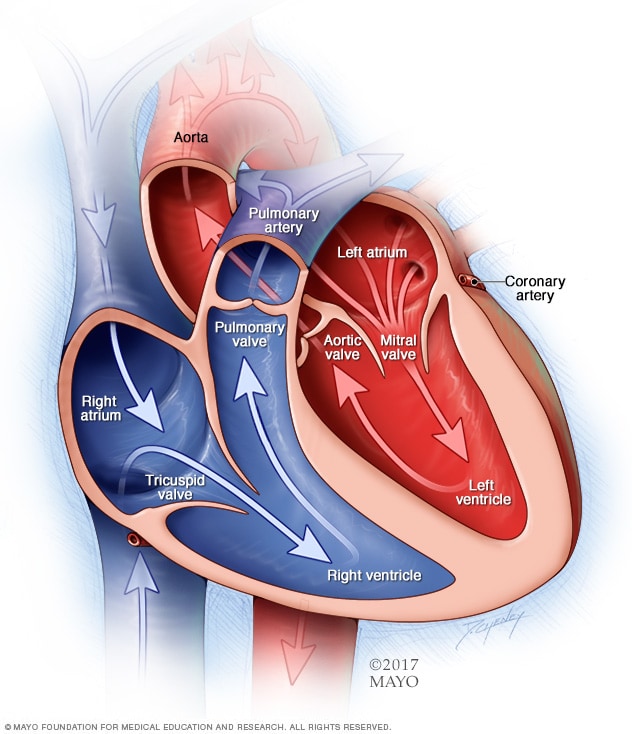Overview
Chambers and valves of the heart

Chambers and valves of the heart
A typical heart has two upper and two lower chambers. The upper chambers, the right and left atria, receive incoming blood. The lower chambers, the more muscular right and left ventricles, pump blood out of the heart. The heart valves help keep blood flowing in the right direction.
Tricuspid valve disease is a type of heart valve disease, also called valvular heart disease. The valve between the two right heart chambers, called the right atrium and the right ventricle, doesn't work as it should. The heart must work harder to pump blood to the lungs and the rest of the body.
Tricuspid valve disease often happens with other heart valve diseases.
There are different types of tricuspid valve disease. Symptoms and treatment depend on the specific valve condition. Treatment may include regular health checkups, medicines, or a procedure or surgery to fix or replace the valve.
Types
There are several types of tricuspid valve disease, including:
- Tricuspid valve regurgitation. The tricuspid valve doesn't close properly. Blood leaks backward into the upper right heart chamber.
- Tricuspid valve stenosis. The valve is narrowed. It's harder for blood to move between the right heart chambers.
- Tricuspid atresia. This condition is present at birth. That means it's a congenital heart condition, also called a congenital heart defect. The tricuspid valve isn't formed. A solid sheet of tissue blocks the blood flow between the right heart chambers.
- Ebstein anomaly. This is a rare heart condition present at birth. The tricuspid valve is in the wrong position and the valve's flaps are not formed correctly. Blood might leak backward through the valve.
Symptoms
Symptoms of tricuspid valve disease depend on the specific valve condition and how severe it is.
Tricuspid stenosis symptoms are often mild. Symptoms may include:
- A fast, pounding heartbeat.
- Fluttering feeling in the neck.
- Fatigue.
People with tricuspid regurgitation may not have symptoms. But the condition may cause vague symptoms such as weakness, fatigue, and swelling in the legs or belly. Sometimes there is a pulsing feeling in the neck veins.
Tricuspid atresia and Ebstein anomaly symptoms often are seen at birth. They may include:
- Blue or gray skin and lips. Depending on skin color, these changes may be easier or harder to see.
- Difficulty breathing.
- Slow growth and poor weight gain.
- Tiring easily, especially during feedings.
Some types of tricuspid valve disease may cause symptoms of right-sided heart failure. Right-sided heart failure symptoms include:
- Fatigue and weakness.
- Shortness of breath.
- Swelling in the legs, ankles and feet.
- Swelling of the belly area, a condition called ascites.
- Sudden weight gain from a buildup of fluid.
When to see a doctor
If you have changes in your heartbeat or unexplained weakness or fatigue, make an appointment for a health checkup. You may be sent to a doctor trained in heart diseases, called a cardiologist.
Causes
Causes of tricuspid valve disease depend on the specific condition.
To understand the causes of heart valve disease, it may be helpful to know how the heart works.
Four valves in the heart keep blood flowing in the right direction. These valves are:
- Aortic valve.
- Mitral valve.
- Pulmonary valve.
- Tricuspid valve.
Each valve has flaps, called leaflets or cusps. The flaps open and close once during each heartbeat. If a valve flap doesn't open or close properly, less blood moves out of the heart to the rest of the body.
Some people are born with tricuspid valve disease. In others, it happens later in life. Some causes of tricuspid valve disease later in life are:
- Infection of the lining of the heart and heart valves, called infective endocarditis.
- A complication of strep throat that's not treated, called rheumatic fever.
- A connective tissue disorder called Marfan syndrome.
- Carcinoid syndrome, caused by a rare tumor that releases certain chemicals.
- Heart tumors or cancer that has spread to the right side of the heart.
- Lupus and other autoimmune diseases.
- Scarring from chest radiation or pacemaker placement.
- An irregular heartbeat called atrial fibrillation (AFib).
- High pressures in the lungs, called pulmonary hypertension.
Risk factors
Risk factors for tricuspid valve disease depend on the specific condition.
Anything that causes swelling or irritation of the right side of the heart or changes in the structure of the valve can increase the risk of tricuspid valve disease.
Oct. 03, 2024